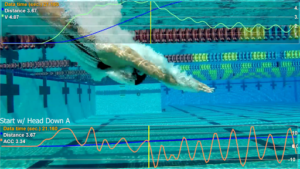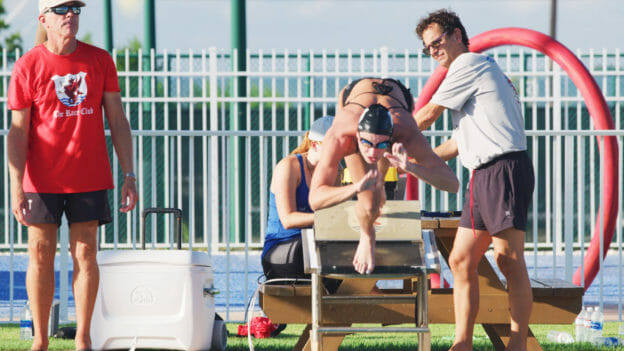 |
Improving Your Starts: Head Lift talks about whether a swimmer should lift the head when leaving the starting block or not. This is a controversial subject. Some coaches teach swimmers to keep their heads down. Others teach them to lift the head on the start. |
The importance of the Head lift on the start
At The Race Club, improving your starts is an important swimming technique that we teach. We consider the head lift as one of the three important coupling motions of the start. The other two coupling motions are the arm motion and the back leg lift. In order to understand the effect of lifting the head versus not lifting the head on the start, we tested Indiana University postgraduate elite swimmer Amanda Kendall in Islamorada last year, using Velocity Meter technology.
Data Gathering
We asked Amanda to do two starts in her traditional way. On the first two, she kept the head held down. Then, she repeated the two starts lifting her head while leaving the blocks on the start. We averaged the data from the two starts using each technique. Here is what we found.
The Result
| Head Down | Head Lifted | |
| Distance to hand entry | 2.64 meters | 2.96 meters |
| Time to hand entry | .84 seconds | .86 seconds |
| Peak Acceleration off the block | 14.37 m/sec2 | 14.96 m/sec2 |
| Peak Velocity (at hand entry) | 4.96 m/sec | 4.91 m/sec |
| Time to 12 meters | 5.56 secs | 5.41 secs |
| Average Velocity to 12 meters | 2.16 m/sec | 2.22 m/sec |
Of all of these measurements, perhaps the most important are the distance to hand entry and the time to 12 meters. With the head lift, Amanda reached the water .28 meters further down the pool, which was an 11% increase in distance to entry. She reached 12 meters .15 seconds sooner with the head lift, representing a 3% reduction in time.

The improvement noted in Amanda’s start from lifting her head turned out to be more convincing than all of the other techniques we tested on the other elite athletes. It seems as if our theory is true that if the swimmer looks forward, he or she tends to go forward. When the swimmer looks down, he or she tends to go down. From this data, we are confident that lifting the head on the start is a better way to begin your race than by keeping the head down.
For a complete comparative analysis of Amanda’s start technique, check out our Race Club video this week in Lane 3 or 4. We hope you enjoy watching Amanda in this newly released video on swimming start technique.
What are you doing with your head on your start and why?
Yours in swimming,
Gary Sr.


Are the results switched in the columns? It looks like the better numbers are in the head down column?
Yes! They got switched by mistake in formatting. We will get changed right away. Thanks for pointing that out.
The results are still switched in the Preview (https://theraceclub.com/?post_type=sc-aquanotes&p=138664&preview=true).
Thanks Larry. Our fault. Should be corrected now.
Hi.
I can understand the coupling movement of the head and the foot .A coupling movement is also to swing the arms in a large circle. If my children are 12 years old but do not have a very strong bounce, is it useful to swing your arms? After all, it takes more time and they start slower from the starting block.
The arm swing should be happening on the way out. Sometimes I see young swimmers initiate the arm swing before pushing off of the block. The hand lifting of the block and the front foot should occur asap after the beep. the back foot is the last to push. I have seen young swimmers do the Tandy start very well and Brad, himself, learned at the age of 7.
Hi sir
Recently I have shifted to track start initially I use to do start with both legs.
Yes you are right i am understanding the head lift is very important coupling motion.
But as I have never practiced that its taking little time for me to get the habit right.
Any exercise or movement practice you recommend to improve head lift as I fear of doing it coz the timing of head lift to head down is something I become panicked, feel like I should not bump or my landing on the water should not affect
Plz guide or suggest
Hello!
I would suggest the exercise we do on land to practice the arm swing & head lift. You’re right, there is a lot of movement happening in a short period of time with this start technique so breaking down the movements into pieces is definitely helpful. Try any of these exercises but that one that I think would be the most helpful for you is around the 3:00 minute mark in the video.
https://theraceclub.com/video/starts-dryland-kasia-wilk-wasick/
Good luck!
Coach Nolan